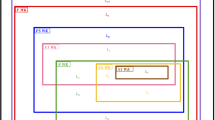Abstract
Watson-Crick (WK) finite automata are working on a Watson-Crick tape, that is, on a DNA molecule. Therefore, they have two reading heads, one for each strand. In traditional WK automata both heads read the whole input in the same physical direction, but in \(5'\rightarrow 3'\) WK automata the heads start from the two extremes and read the input in opposite direction. In sensing \(5'\rightarrow 3'\) WK automata the process on the input is finished when the heads meet, and the model characterise the linear context-free languages. Deterministic variants are weaker, the class 2detLIN is accepted by them. In this paper a new concept, the state-determinism is investigated, that is in each configuration of a computation (if it is not finished yet) the next state is determined by the actual state of the configuration. There are various usual restrictions on WK automata, e.g., all-final, stateless or 1-limited variants. We place the new class, the state-deterministic \(5'\rightarrow 3'\) WK automata, into the hierarchy based on the accepted language classes. Further, various hierarchy results including combined restrictions, e.g., 1-limited all-final state-deterministic \(5'\rightarrow 3'\) WK automata are shown.










Similar content being viewed by others
References
Adleman LM (1994) Molecular computation of solutions to combinatorial problems. Science 226:1021–1024
Czeizler E, Czeizler E (2006) A short survey on Watson-Crick automata. Bull EATCS 88:104–119
Czeizler E, Czeizler E, Kari L, Salomaa K (2008) Watson-Crick automata: determinism and state complexity. DCFS 2008:121–133
Czeizler E., Czeizler E., Kari L., Salomaa K. (2009) On the descriptional complexity of Watson-Crick automata. Theor Comput Sci 410(35):3250–3260
Freund R, Păun Gh, Rozenberg G, Salomaa A, (1997) Watson-Crick finite automata, In: 3rd DIMACS Sympozium On DNA Based Computers, Philadelphia, pp. 305–317
Giambruno L, Restivo A (2008) An automata-theoretic approach to the study of the intersection of two submonoids of a free monoid. RAIRO Theor Inf Appl 42(3):503–524
Hegedüs L, Nagy B, Egecioglu Ö (2012) Stateless multicounter \(5^{\prime } \rightarrow 3^{\prime }\) Watson-Crick automata: the deterministic case. Nat Comput 11(3):361–368
Hopcroft JE, Ullman JE (1979) Introduction to automata theory, languages and computation. Addison-Wesley, Boston
Kari L, Mahalingam K (2010) Watson-Crick palindromes in DNA computing. Nat Comput 9(2):297–316
Kocman R, Nagy B, Krivka Z, Meduna A (2018) A jumping \(5^{\prime } \rightarrow 3^{\prime }\) Watson-Crick finite automata model. NCMA 2018:117–132
Kuske D, Weigel P (2004) The role of the complementarity relation in Watson-Crick automata and sticker systems, In: Developments in Language Theory, DLT 2004, Lecture Notes in Computer Science, LNCS 3340, Springer, Berlin, Heidelberg, pp. 272–283
Leupold P, Nagy B (2010) \(5^{\prime } \rightarrow 3^{\prime }\) Watson-Crick automata with several runs. Fundamenta Informaticae 104:71–91
Nagy B (2007) On \(5^{\prime } \rightarrow 3^{\prime }\) sensing Watson-Crick finite automata, In: Preproceedings of DNA13: The 13th International Meeting on DNA Computing, Memphis, Tennessee, USA, 327–336
Nagy B (2008) On \(5^{\prime } \rightarrow 3^{\prime }\) sensing Watson-Crick finite automata, In: Garzon M. H., Yan H. (eds): DNA Computing. DNA 2007: Selected revised papers, Lecture Notes in Computer Science, LNCS 4848, Springer, Berlin, Heidelberg, pp. 256–262
Nagy B (2009) On a hierarchy of \(5^{\prime } \rightarrow 3^{\prime }\) sensing WK finite automata languages, In: Computaility in Europe, CiE 2009: Mathematical Theory and Computational Practice, Abstract Booklet, Heidelberg, pp. 266–275
Nagy B (2010) \(5^{\prime } \rightarrow 3^{\prime }\) Sensing Watson-Crick Finite Automata, pp. 39–56, In: Gabriel Fung (ed.): Sequence and Genome Analysis II—Methods and Applications, iConcept Press
Nagy B (2013) On a hierarchy of \(5^{\prime } \rightarrow 3^{\prime }\) sensing Watson-Crick finite automata languages. J Logic Comput 23(4):855–872
Nagy B (2020) \(5^{\prime } \rightarrow 3^{\prime }\) Watson-Crick pushdown automata. Inf Sci 537:452–466
Nagy B, Otto F (2011) Finite-state acceptors with translucent letters, in BILC 2011: AI Methods for Interdisciplinary Research in Language and Biology, Proc., G. Bel-Enguix,V. Dahl, and A.O. De La Puente (eds.), SciTePress, Setubal, Portugal, pp. 3–13
Nagy B, Otto F (2011) Globally deterministic CD-systems of stateless R(1)-automata, LATA 2011. LNCS 6638:390–401
Nagy B, Otto F (2013) On globally deterministic CD-systems of stateless R-automata with window size one. Int J Comput Math IJCM 90:1254–1277
Nagy B, Otto, F (2020) Linear Automata with Translucent Letters and Linear Context-Free Trace Languages, RAIRO Theoretical Informatics and Applications—RAIRO ITA 54, article number 3, p. 23
Nagy B, Parchami Sh (2021) On deterministic sensing \(5^{\prime } \rightarrow 3^{\prime }\) Watson-Crick finite automata: a full hierarchy in 2detLIN, Acta Informatica 58:153–175. https://doi.org/10.1007/s00236-019-00362-6
Nagy B, Parchami Sh, Sadeghi HMM (2017) A new sensing \(5^{\prime }\rightarrow 3^{\prime }\) Watson-Crick automata concept, AFL 2017, Proceedings 15th International Conference on Automata and Formal Languages, EPTCS 252, pp. 195–204, https://doi.org/10.4204/EPTCS.252.19
Parchami Sh, Nagy B (2018) Deterministic Sensing \(5^{\prime }\rightarrow 3^{\prime }\) Watson-Crick Automata Without Sensing Parameter. UCNC 2018, LNCS 10867, pp. 173–187
Păun Gh, Rozenberg G, Salomaa A (2002) DNA computing: new computing paradigms. Springer-Verlag, Berlin
Ray KS, Chatterjee K, Ganguly D (2015) State complexity of deterministic Watson-Crick automata and time varying Watson-Crick automata. Nat Comput 14(4):691–699
Rozenberg G, Salomaa A (eds) (1997) Handbook of formal languages. Springer, Berlin
Sempere JM (2004) A representation theorem for languages accepted by Watson-Crick Finite Automata. Bull EATCS 83:187–191
Sempere JM (2018) On the application of Watson-Crick finite automata for the resolution of bioinformatic problems, NCMA 2018 (invited talk), pp. 29–30
Author information
Authors and Affiliations
Corresponding author
Additional information
Publisher's Note
Springer Nature remains neutral with regard to jurisdictional claims in published maps and institutional affiliations.
Rights and permissions
About this article
Cite this article
Nagy, B. State-deterministic \(5'\rightarrow 3'\) Watson-Crick automata. Nat Comput 20, 725–737 (2021). https://doi.org/10.1007/s11047-021-09865-z
Accepted:
Published:
Issue Date:
DOI: https://doi.org/10.1007/s11047-021-09865-z




